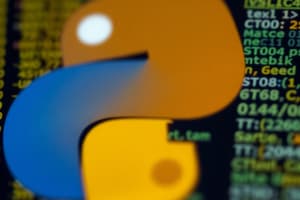Podcast
Questions and Answers
What is the data type of the variable if it is assigned a value such as 'hello'?
What is the data type of the variable if it is assigned a value such as 'hello'?
- float
- int
- complex
- str (correct)
What is the main difference between lists and tuples?
What is the main difference between lists and tuples?
- Lists are used for strings, tuples are used for numbers
- Lists are mutable, tuples are immutable (correct)
- Lists are immutable, tuples are mutable
- Lists are used for numbers, tuples are used for strings
Which data type is used to represent true or false values?
Which data type is used to represent true or false values?
- str
- int
- float
- bool (correct)
What is the data type of a collection of unique items that can be used for set operations?
What is the data type of a collection of unique items that can be used for set operations?
Which data type is used to represent decimal numbers?
Which data type is used to represent decimal numbers?
What is the data type of a collection of key-value pairs?
What is the data type of a collection of key-value pairs?
Flashcards are hidden until you start studying
Study Notes
Data Types in Python
Numeric Types
- Integers (
int): whole numbers, e.g.,1,2,3, etc. - Floating Point Numbers (
float): decimal numbers, e.g.,3.14,-0.5, etc. - Complex Numbers (
complex): numbers with real and imaginary parts, e.g.,3 + 4j,-2 - 3j, etc.
Sequence Types
- Strings (
str): sequences of characters, e.g.,'hello',"hello", etc.- Can be enclosed in single quotes or double quotes.
- Can be concatenated using the
+operator.
- Lists (
list): ordered collections of items, e.g.,[1, 2, 3],['a', 'b', 'c'], etc.- Can be indexed and sliced.
- Can be modified (mutable).
- Tuples (
tuple): ordered, immutable collections of items, e.g.,(1, 2, 3),('a', 'b', 'c'), etc.- Similar to lists, but cannot be modified.
Mapping Type
- Dictionaries (
dict): unordered collections of key-value pairs, e.g.,{'name': 'John', 'age': 30}, etc.- Keys must be unique and immutable.
- Values can be of any type.
Set Types
- Sets (
set): unordered collections of unique items, e.g.,{1, 2, 3},{'a', 'b', 'c'}, etc.- Automatically remove duplicates.
- Can be used for set operations (union, intersection, difference, etc.).
- Frozensets (
frozenset): immutable sets, e.g.,frozenset({1, 2, 3}), etc.- Similar to sets, but cannot be modified.
Boolean Type
- Booleans (
bool): represent true or false values, e.g.,True,False, etc.
Binary Type
- Bytes (
bytes): sequences of integers in the range 0 <= x < 256, e.g.,b'hello', etc. - ByteArray (
bytearray): mutable sequences of integers in the range 0 <= x < 256, e.g.,bytearray(b'hello'), etc.
Data Types in Python
Numeric Types
- Integers (
int) are whole numbers, such as 1, 2, 3, etc. - Floating Point Numbers (
float) are decimal numbers, such as 3.14, -0.5, etc. - Complex Numbers (
complex) are numbers with real and imaginary parts, such as 3 + 4j, -2 - 3j, etc.
Sequence Types
- Strings (
str) are sequences of characters, such as 'hello', "hello", etc.- Can be enclosed in single quotes or double quotes.
- Can be concatenated using the
+operator.
- Lists (
list) are ordered collections of items, such as [1, 2, 3], ['a', 'b', 'c'], etc.- Can be indexed and sliced.
- Can be modified (mutable).
- Tuples (
tuple) are ordered, immutable collections of items, such as (1, 2, 3), ('a', 'b', 'c'), etc.- Similar to lists, but cannot be modified.
Mapping Type
- Dictionaries (
dict) are unordered collections of key-value pairs, such as {'name': 'John', 'age': 30}, etc.- Keys must be unique and immutable.
- Values can be of any type.
Set Types
- Sets (
set) are unordered collections of unique items, such as {1, 2, 3}, {'a', 'b', 'c'}, etc.- Automatically remove duplicates.
- Can be used for set operations (union, intersection, difference, etc.).
- Frozensets (
frozenset) are immutable sets, such as frozenset({1, 2, 3}), etc.- Similar to sets, but cannot be modified.
Boolean Type
- Booleans (
bool) represent true or false values, such as True, False, etc.
Binary Type
- Bytes (
bytes) are sequences of integers in the range 0 ≤ x < 256.
Studying That Suits You
Use AI to generate personalized quizzes and flashcards to suit your learning preferences.




